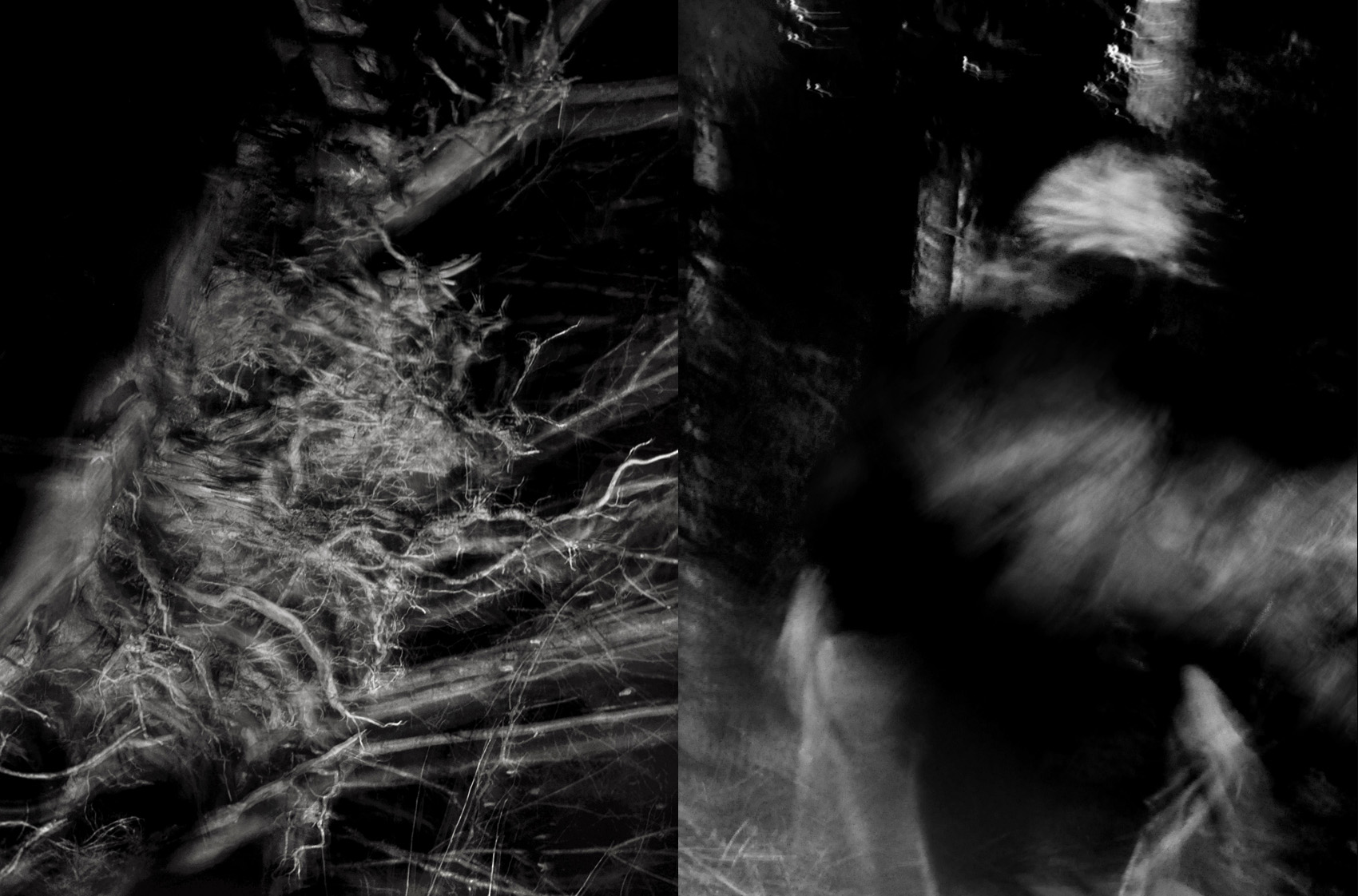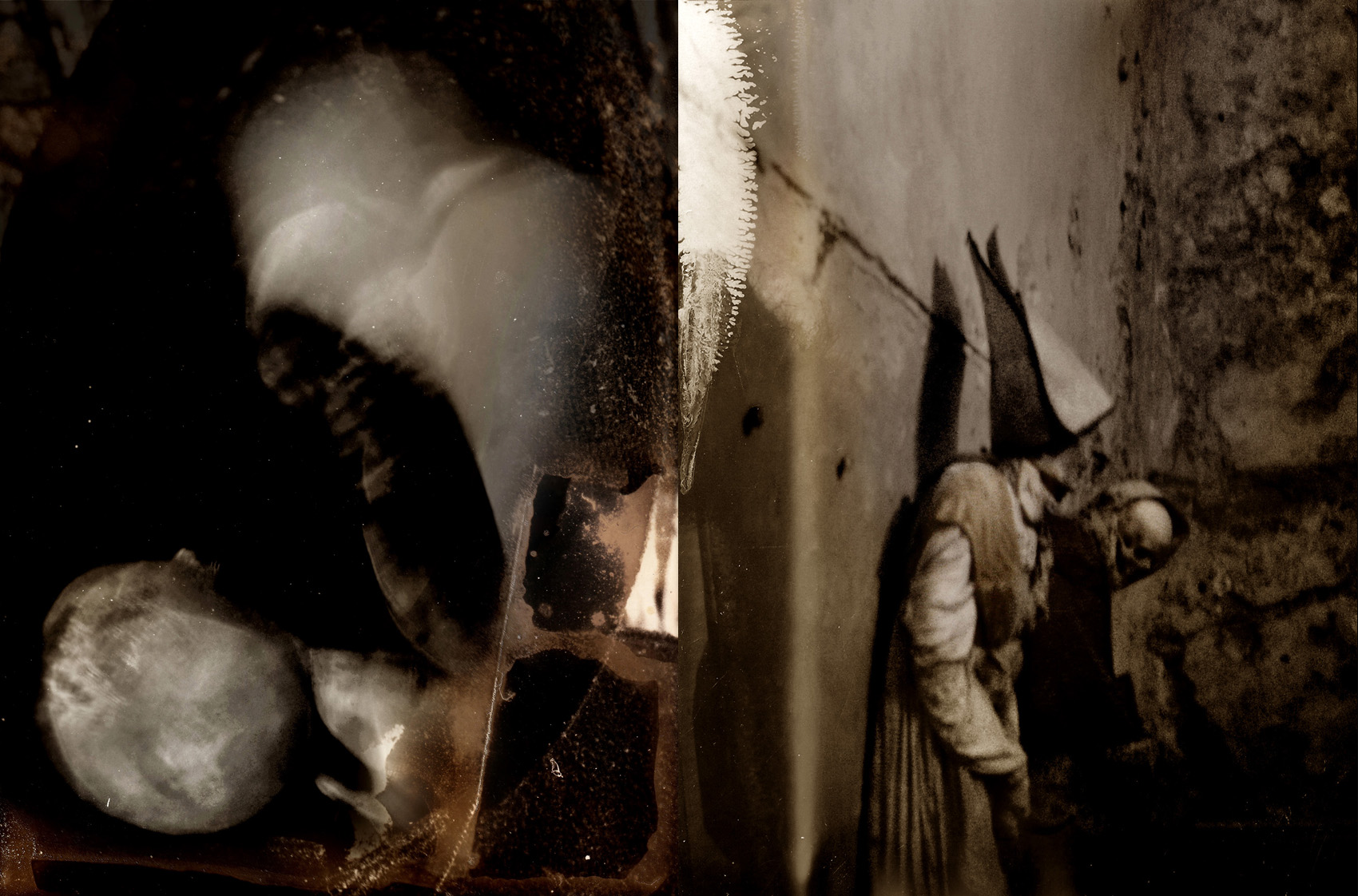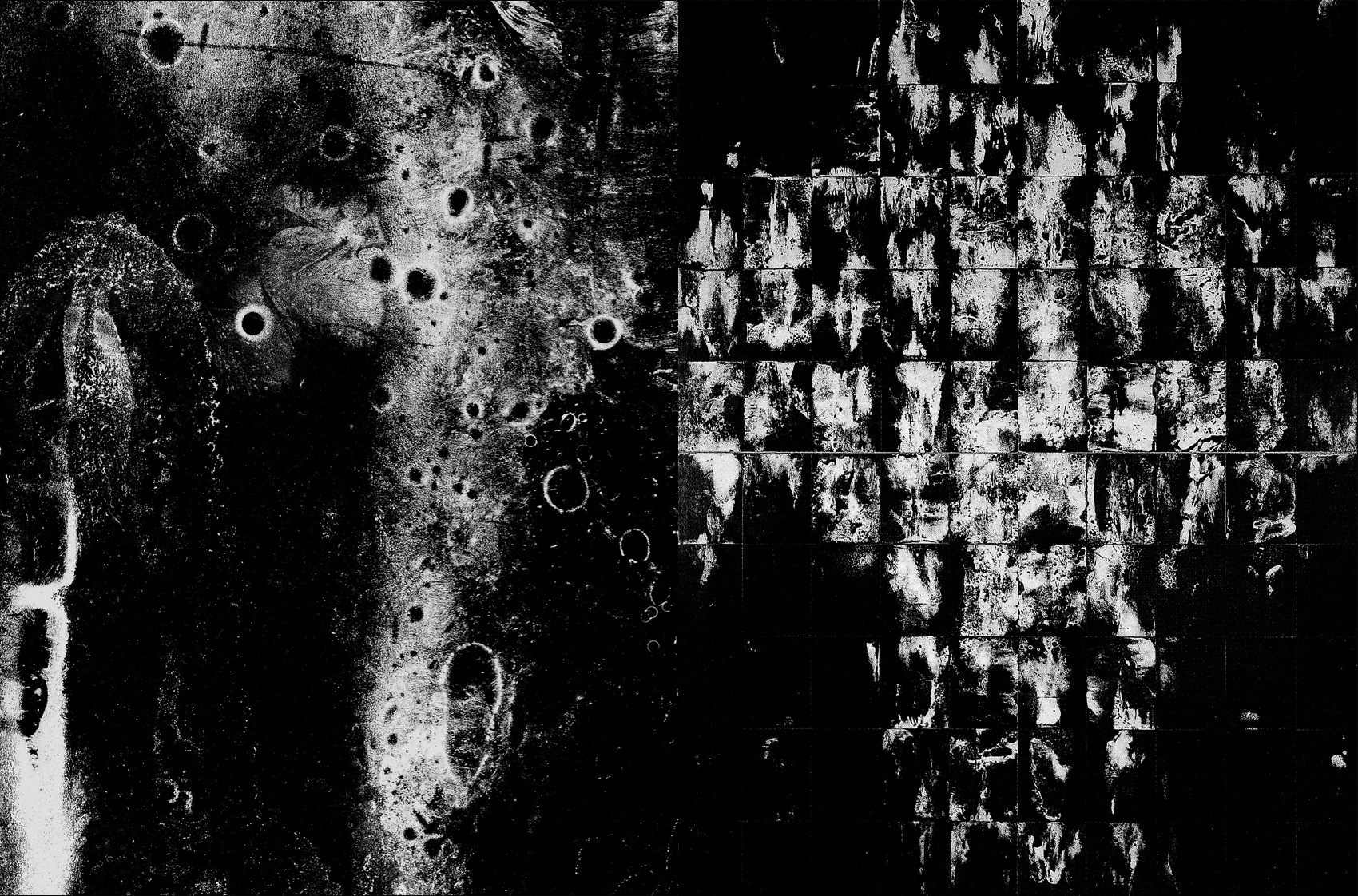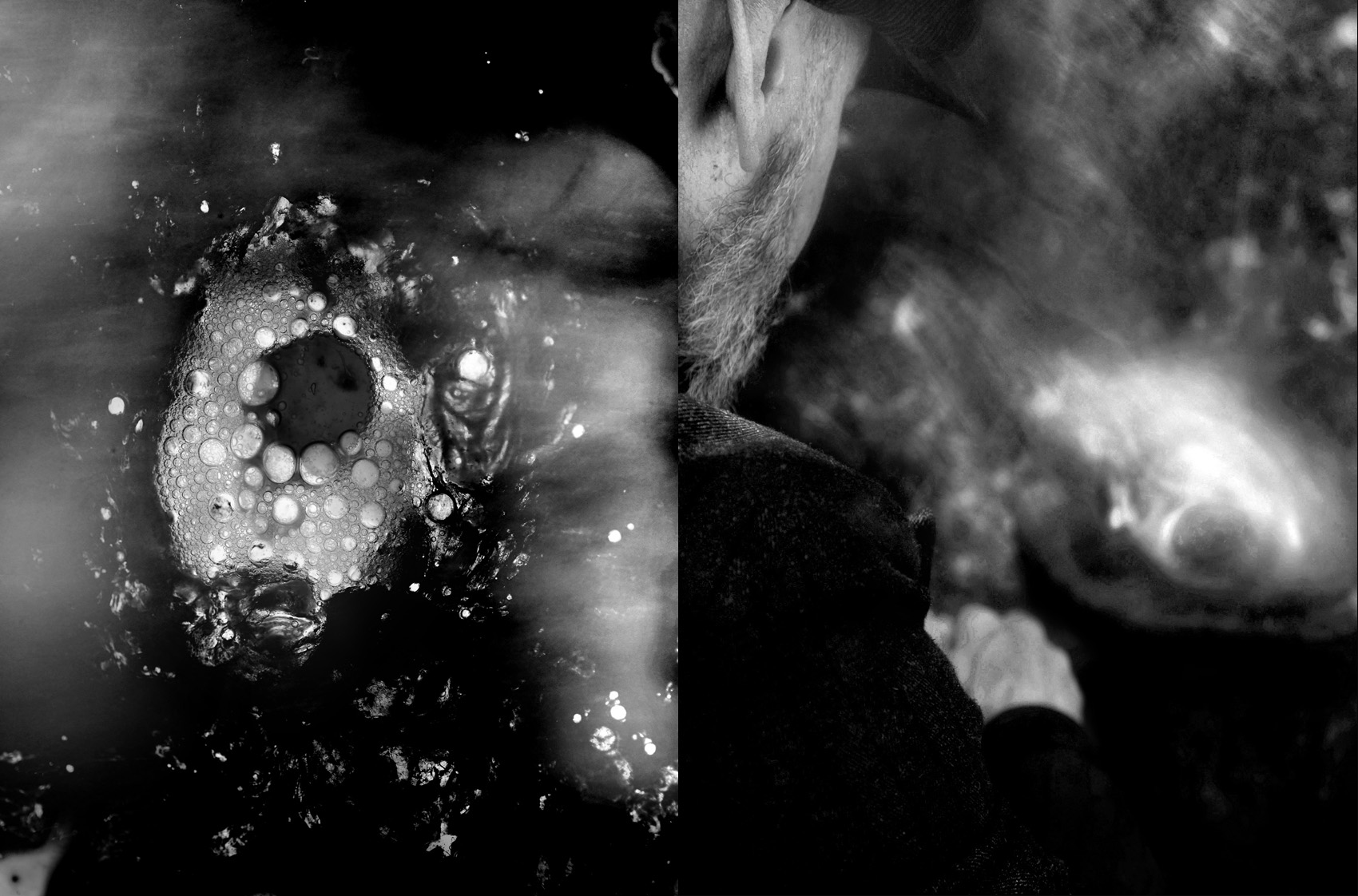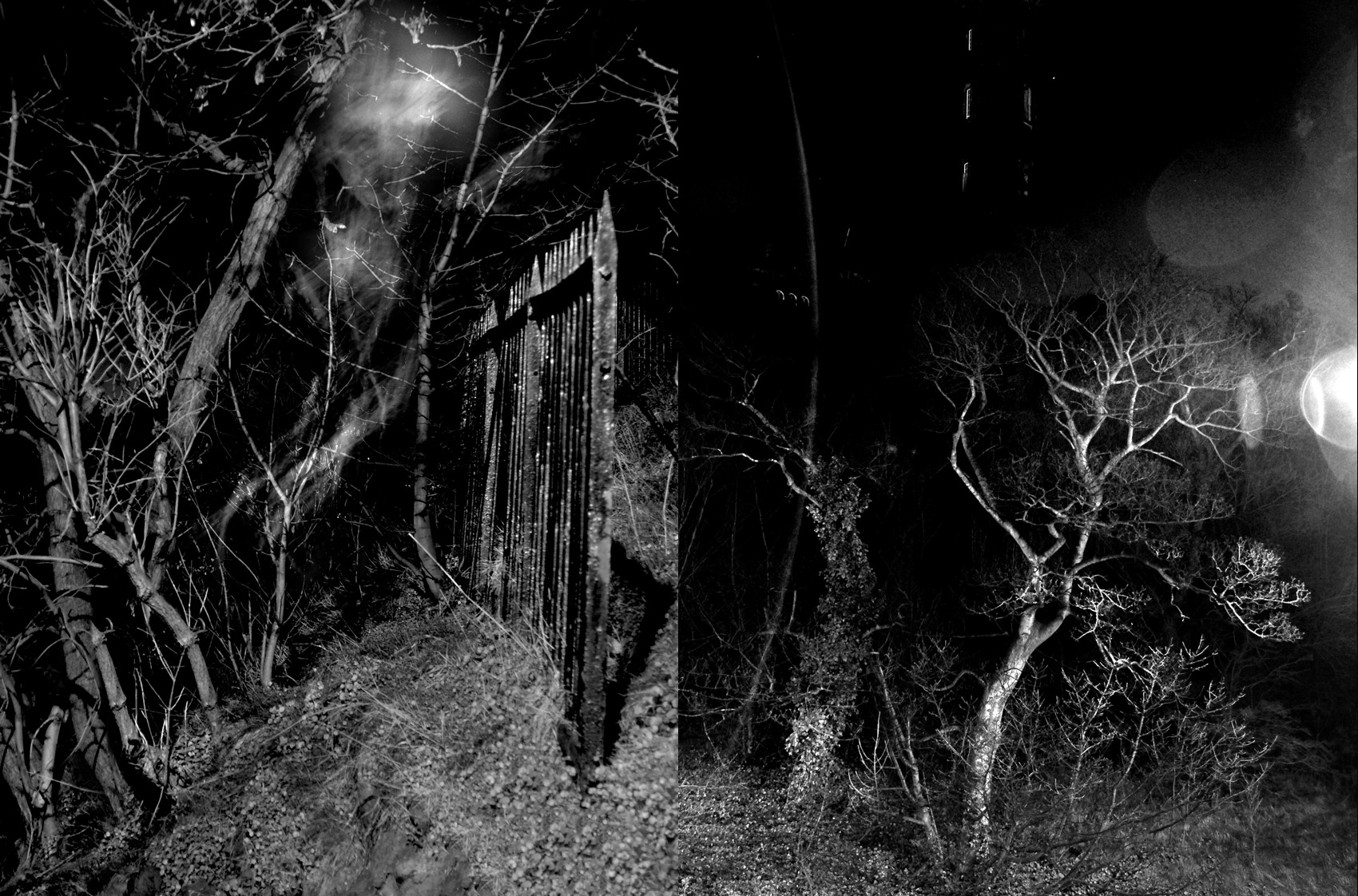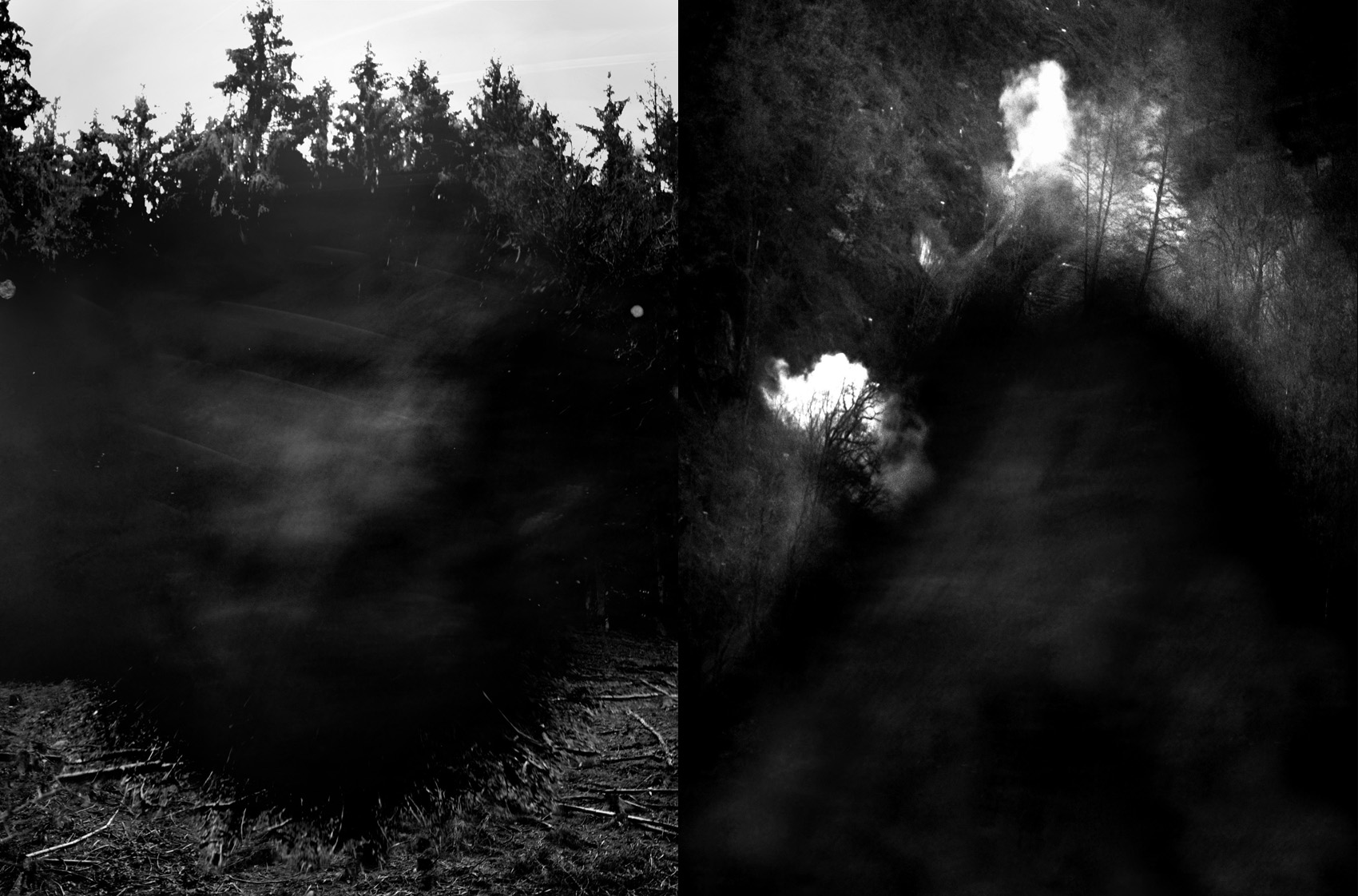OCCULT PHOTOGRAPHY
24th of October 2025: I had an exciting exchange with Harper Feist about occult photography, which she published in her podcast ‘ThelemaNOW’.
You can listen to it at https://thelemanow.org/thelema-now-guest-gast-bouschet
Here is the written version:
A conversation for Thelema NOW! Crowley, Ritual & Magick. A monthly podcast by Harper Feist featuring in-depth interviews with individuals involved in mysticism, spirituality, and magic.
Gast Bouschet is a visual artist and occult philosopher. Since the 1980s, alone or in collaboration with Nadine Hilbert, he has created a complex body of work that challenges the fundamental principles underlying structure, visibility and power. His work spans a wide range of media, including photography, sound, video, painting, sculpture and writing.
Bouschet’s art has been shown internationally in numerous exhibitions (including Ujazdowski Castle Centre for Contemporary Art, Warsaw Poland; BPS22 Museum Charleroi, Belgium; Serralves Museum of Contemporary Art Porto, Portugal; Darling Foundry Montreal, Canada; Cube Space Taipei, Taiwan; Philharmonie, Luxembourg; Opderschmelz, Dudelange, Luxembourg; Muzeum Sztuki Lodz, Poland; Casino Forum d’Art Contemporain, Luxembourg; Mudam Contemporary Art Museum of Luxembourg; Busan Biennale of Contemporary Art, South-Korea; Camouflage Johannesburg, South Africa; MUHKA Antwerp, Belgium; Contretype Brussels, Belgium and CCA Glasgow, Scotland, to name a few. Together with Nadine Hilbert, he represented Luxembourg at the 53rd Venice Biennale.)
In recent years, Gast Bouschet has increasingly focused on what has been described as a primordial and uniquely blackened eco-sorcery that he practices away from the public eye in theArdennes Forest.
His most recent published work was Anarch, published by Scarlet Imprint in 2023. It is a masterwork.
Gast, Acher and I have been in contact via Instagram and email for several years. We recently had a long conversation about photography that I would like to share. Some of what we discussed ended up in his subsequent series of Instagram posts entitled ‘Occult Photography’.
Gast has trouble speaking due to chronic pain in his tongue, and so does most of his communication through written means. Because of that and the desire to share this material in an audio medium, Gast has given permission for me to combine parts of our chat with his written work on occult photography and have Frater Acher read his words. Thanks so much to you, Gast, for letting us make your words, your sorcerous work and your photographer’s eye available to the ThelemaNOW audience, and thank you, Frater Acher, for being the voice of Gast Bouschet.
As this discussion started with Gast urging me to post about my ritual work more often, I will simply start with his thoughts about the post I made in part because of his encouragement:
G. Beautiful images! Deeply romantic, in the best sense of a longing for the world. Thank you for sharing them.
I am very happy to be able to make a small contribution to enabling you to share your ritual work here. Not because everything should be shared. It shouldn’t. But because it relates to what you write about, that tensions need to be created and maintained. It’s about enduring what moves us and seeing it reflected out there in the world.
As a sorcerous artist, I also think that tensions should be materialised so that we can keep them in front of us and look at them from different angles. Not to dissolve them, but to work with them.
I understand very well when you write that you feel shy to express what is sacred to you. And you’re right, it leads to judgement. These are healthy attitudes that should be preserved and preferred over those who show off their devotion. You know, I am messed up in this regard because I have been working as an artist for so long. As an artist, you always walk somewhat naked through the world. There is a lot of exhibitionism in this, but also boldness and the power to overcome fear. Fear is overrated. It may protect us sometimes, but overall, it destroys more than it preserves. And it has no place in art at all. Art has to be totally fearless!
Artistic and occult work are fundamentally opposed. Art strives for visibility, occult practices for the preservation of secrets. That, too, is a tension that cannot be resolved when we do what we do on social media.
Be that as it may, being in the world means encountering its fractures and ours. The skulls and landscapes you depict so beautifully have them too. From these fractures grows the wisdom of being part of the world.
H. This text is full of important complexity… Again, you’re helping me clarify what’s necessary, what’s helpful.
The thing that is rattling loose for me now is the way I am not an artist.
I think, at least speaking of now, I am disappearing from other’s experience into my own. It’s hard to tell my stories in a way that it didn’t used to be.
Maybe this process is like breathing and at some point I will hit the other part of the cycle? Maybe all the huge and wonderful changes of the last year have expression too energetically costly?
I am trying to access my natural rhythm here, and for a change not do what the world requests or demands… but this is really a razor’s edge.
You‘ve made this more of a question than a statement, though. When I see your posts, I smell dirt and blood, I experience a ritual within myself, put there by your work, and Sharon’s now.
How can that not now be a part of my natural rhythm? It’s a Stoppard question: how can I not be myself?
G. Our place in the world is primarily defined by our focus. Being an artist is fundamentally characterised by focus. People enjoy seeing someone who has mastered a craft to such an extent that their creations are beautiful to look at. Ultimately, however, it doesn’t matter what something looks like when you have to decide whether it is art or not. As Duchamp showed us more than a hundred years ago, it all comes down to our perception. Perhaps there is no such thing as art, only people who turn something into art through their selective view of the world. In photography, it depends on which frame we choose and how we use what the camera captures to generate an impact. I think we are an artist when we focus on being one.
Perhaps it’s time to reconsider it all, including Duchamp’s perspective. For decades, I’ve been asking myself whether something is art if nobody looks at it. Another question is whether only humans make art or if animals do too. And can the behaviour of crystals, for example, be described as artistic? Does it matter what we call it?
As a young artist, I experimented a lot with photograms, which are essentially planetary records, their deep shadows hinting at the abyss beneath the two-dimensional image. My favourite photographs are not those that make me think and reflect on what I see, but those that pull the ground from under my feet. Those that express l’appel du vide, the call of the void. The photos that matter most to me are the ones that unground us.
Photographs only become magical for me when I sense the fundamental restlessness that underlies them. To access the demonic dimension that hides in the midst of the perceptual world, one has to give up total control over the image and not discard what appears unsuccessful at first glance, but work with it.
What fascinated me about the cameraless photographs was that they revealed the perspective of things. This is what we would now call the non-human gaze in the philosophies of materiality. In the late 1980s and early 1990s, when I was working on these pieces, such a magical engagement with materiality was hardly considered in the art world, and thinking about it was far from being part of the academic mainstream as it is today.
H. I have many questions and comments… the first is the weird overlap between what you have written here and the old trope of the noble savage being concerned that his soul will be stolen if he is photographed. I don’t know that was an actual „thing,“ but I thought a lot about it as a young person. I thought about it a lot when I was first using cameras in pursuit of expression, but also again when I served as a photographic model in my twenties. Was my soul stolen? Maybe it was compromised by the urge to be photographed? The second is that because of the apparent time stoppage that occurs in photography, maybe un-incarnated beings have a special door through which to join the meat crew.
G. In relation to the fact that photography robs the soul. There is a book by Sinthujan Varatharajah: “an alle orte die hinter uns liegen” (in German only, I’m afraid) that deals with photography as a weapon of colonial subjugation. He/she writes that the use of the camera is a deliberate attempt by Europeans to assert their own humanity by subjugating other life forms. And that it helped to emphasise the central distinction of colonial modernity, which differentiated between human, sub-human and non-human. It thus became a control medium and weapon that was used against the interests of the colonised people in a similar way to the guns, bibles and maps of the Europeans. It created an order over what was perceived as wild, chaotic and threatening..
I see it as similar to the exorcism practised by the church. When the Church names the demon, it gains power over it. So if you photograph someone, you gain power over them and possess their soul. I once wrote the following about this in a text about my video installation Collision Zone: As an artist whose work relies heavily on photography and video, I can’t help but point out the dominance that these media exert, whether we consider our images politically motivated or not. No one in our technologically advanced world is innocent of the prevailing conditions. Certainly some bear greater responsibility than others, but ultimately we all play a role in the exercise of political power, consciously or not. When we turn our camera on the world, we do not depict it as it is, but take possession of it and impose our view on it. The demonic aspect inherent in the word “possession” is deliberately chosen here. We gain control over the world and make it our own. But not only photography and video do this. In general, our cultural endeavours direct the chaotic flow of life into orderly channels that we have drawn to give it direction and derive artistic and financial gain from it.
But despite all my criticism of something that ultimately springs from cultural colonialism, I still believe in the sorcerous power of art. It gives us the possibility to fundamentally change our view of the world if we fully engage with its ambiguity.
H. Photography as subjugation … thinking about that. In the beginning, I am not sure it wasn’t explorers wanting to prove their importance. Or maybe in a more pure form, wanting to share the world with others. There is a sense in which is presents only a tiny, flattened version of a perhaps vast and foreign system, but that kind of control is arguably ineffective.
From my perspective, it’s interesting and fun to try to extrapolate the missing dimensions. But that is part of my personal magical practice, I guess.
The question of control is more important now, though, than when people were dragging large format cameras around the Amazon. PsyOps is warfare and the story that gets told about a photograph completely dominates the impression people will ingest.
G. Well. I don’t doubt that individual explorers were motivated by what you describe, namely wanting to share the world with others. The problem is that they did so within a system that was and is built on exploitation and domination. The images turn the people they depict into something other than how they see themselves, into something they no longer have control over. Photos are never neutral, but are shaped by the perspective we project onto the world and people. In my opinion, they are political tools. They have the power to subjugate, and they have the power to undermine subjugating systems. But they always have power. It just depends on how we use it.
H. That is certainly true, but it could be said that we never have control over what people think of us, even if we’re face to face. And what motivations others have? We never know or control that either. We all want something from other people, even if it’s just to be recognized as another person… On the topic of photography as a political tool: There was a time in the US where indigenous people were brought to Washington like animals for display. I recognize that photography was used in place of this at times, and is in this context a better option.
It feels to me right now as if photography is one flavor of experiencing other people, a 2D image of a complex and rich 3D system. It’s only one way of making that “sampling,” and it easier to see it as an incomplete representation of an entire system than our own personal experience. However, it’s not as different as we sometimes pretend.
G. These are complex and far-reaching issues that we are addressing here. I agree with everything you write. But looking someone in the face is different from taking away their image. Varatharaja writes that being photographed was a deeply traumatic experience for many. They lived on in the photos as caricatures that developed a life of their own, detached from their bodies and the places where they lived. Something was irrevocably taken from them. And that the photos are not proof of their existence, but of their subjugation. But perhaps we should talk about how we can use photography (and our texts and art in general) as sorcerous weapons to subvert the mechanisms of subjugation. My Instagram post from today resonates with that I think.
H. That is absolutely tied to the notion that something is stolen from living people when they are photographed. I think a key aspect of this is the fact the photograph is stuck in time. This must surely (at least) account for the fact that photographs often do not look like the photographed. Can the alteration or destruction of photographs unlock beings frozen in time?
G. It would be presumptuous of me to claim that I have a definitive answer. However, I can offer some ideas that are compatible with a philosophical approach known as speculative realism. One strand of this approach is object-orientated ontology. There are aspects of it that might be helpful here. OOO emphasises the autonomy of objects. This also applies to photographs, which are objects with their own properties. From this perspective, a photograph is not just an image of something else, but an object with an independent existence. I would see the photograph as a kind of demonic superposition, consisting of the image of the person (or thing) from whom the photograph was taken (perhaps even his/her soul, or at least a partial aspect of it), which he has voluntarily allowed to be taken or has been stolen from him/her, the photographer who took the photograph and thus appropriates the power over the image and the image of whom or what was captured on it, and the photograph itself, which has an independent identity and, like all objects, has an essential reality beyond its relationships and properties. And which eludes both the depicted and the photographer and the viewer in its very nature. It seems important to emphasise this, as it draws attention to the fact that altering or destroying photographs interferes with all these aspects. It has multiple effects. So what is activated by the manipulation of photographs is not necessarily the people frozen in time; our gesture interferes with all the realities and existences involved.
H. That does make sense. The photograph, the way you’re looking at it, is a system. Each member of the system may be impacted by the destruction of the photograph in unique ways. Could we see that as ecological destruction of a swamp, maybe? The animals would have no place to live, the water no place to pool without flooding. The plants would be killed outright or swept away, maybe would die in the longer term because of lack of nutrients. But I think this is important for at least two reasons: firstly there is the release of the beings somehow contained in the photograph. This is of vital importance, we should know how to release what it is that we intentionally or unintentionally trap. The second is the way this mirrors onto more classic spirit contact. Think of the grimoire with the brass vessel for the mouthy or inconvenient spirit… how do we let him or her go? We must know how to hang up the phone gracefully when we go to talk to anyone.
G. A swamp or other ecosystem seems to me an accurate way to imagine what is going on in photographic materiality. I agree with you that we should strive to understand how to free what we hold captive. We should also strive to master the art of letting go of ghosts when they take hold of us. Honestly, I do not always succeed. Some ghosts are so persistent that they lurk in my dreams, waiting to overwhelm me when I let go of control. I forgot to mention that I distinguish between the powers that I summon to open myself up to their presence, and the ones that I try to exorcise.
H. And along that track, let’s return to the topic of photographs as political weapons… Do you think having the constant ability to alter the photos has changed this? I think for people paying attention, they are less dangerous. I also think there are not enough people paying attention.
G. If I remember correctly, it was Stalin who was the first to have people removed from photos. Or at least one of the first. When I was a young photographer, I too laboriously manipulated photos in the darkroom to use them to bring about change. Nevertheless, digital photography and now AI have given manipulation a dimension that was previously unimaginable. It has obvious political power, and I am waiting for the first truly world-changing manifestation of it. It has probably already happened without us noticing. Surely it helps to be attentive, but the possibilities for deception through images are so advanced and will continue to develop in the coming years to a point where it will no longer be possible with the naked eye to recognise ‘fakes’, if we want to call them that. That said, I agree with you that people are not attentive. If you present them with a certain situation, they will fill in the rest in a way that fits their world view and their expectations. Here’s a funny example: when Nadine and I got married many years ago, we sent out cards to invite friends for a drink. The cards showed Nadine and an unkown man sitting next to her holding an iguana (that we had met by chance and posed with for a photo). He bore a vague resemblance to me because he was also bald and had a beard similar to mine. But you couldn’t really say that he looked like me. Nevertheless, many people thought it was me because the situation in which we sent the image invited them to assume that it was me sitting next to Nadine, haha!
H. Your marriage announcement is a great example of people assuming they knew what was going on. There are several really funny instances of this sort of thing in psychological research. My favorite is the movie of the equal number of people wearing black and white t-shirts and bouncing a basketball. The subject is asked to count the number of times each team bounces the ball. While the subject is performing this task, a man in a gorilla costume wanders through the basketball court. Many people (a majority, I don’t recall well) do not see the gorilla.
But the issue of photographic fakes nowadays is, as you adroitly point out, is a whole other thing. The more critical of us must now assume that everything is faked. The assumption is not that something is probably “real,” but the exact opposite. What this will do to human thought and emotion is up for grabs.
On a humorous note, I was the first Stalin at the company I worked for upon graduation with my PhD. We had a wall of photos in our company intranet showing everyone with their title, name, and office number. The lead of atmospheric chemistry was a grumpy curmudgeon. I put his head on Nicole Kidman’s body, wearing a white sequined dress. The day after I did that, management denied ordinary employees electronic access to the Wall of Woe. I’m still proud of it.
G. On the issue of photographic fakes, what you are highlighting here is something very important, I think. Until now, we assumed that what was published had a real basis in most cases and was only ‘tricked’ in exceptional cases to mislead us or to profit from misinformation. Now it’s the other way around, and basically what is true now has to prove that it is. This leads to a completely different attitude towards images and information in the world. Thank you for this insight.
The following sections is Gast talking about occult photography, based on posts made in Instagram and illustrated with Gast’s work together with Sharon Moyal.
Occult Photography. Part One.
What I refer to as “occult photography” has been the foundation of my practice since the beginning and supports all other forms of expression I use. I have touched upon it occasionally in essays and posts, but have never delved into the ontological core of the medium. This is why I have decided to explore it in more depth. I intend to write about it from a practical perspective!
Jacques Derrida’s statement that ‘every photograph is of the sun’ becomes ‘every occult photograph is of the black sun’ in sorcerous theory and practice. Actually, my essay could end here, so essential is this insight. I therefore ask you not to rush on, but to reflect on both Derrida’s statement and its sorcerous counterpart.
Derrida’s argument about photography concerns sunlight, whose source is not visible in the image. In occult photography, however, as I conceive of it, the focus is on the darkness between the stars and the hidden radiance that emanates from it. Occult photography foreshadows the dark light that is not accessible to normal sight.
Let’s start at the beginning. The word ‘photography’ means ‘writing with light’, but we could just as easily call it ‘skiagraphy’, which means ‘writing with shadows’. It is the art of capturing Urbilder — primal images that act as gateways into the abyss of unknowing. Sharon Moyal called it ‘converting attention into gravity’ in one of our conversations.
My view of photography is shaped by mystical thinking, although I must say that this is a form of mysticism without God. The inner light I speak of is therefore not divine. However, it expresses the dark sacred. To follow my train of thought, you must venture with me into speculative territory that can only be explored to a limited extent with scientific arguments. Occult photography reveals poetic truths. However, I believe that scientific findings can complement and reinforce such findings. Think of them as bridges that will prevent us from falling into the abyss before we have even begun our real journey.
Occult Photography. Part Two.
I first came into contact with photography when I was given a Polaroid camera for my first communion, which printed black-and-white photos directly onto paper. The chemicals were part of the print itself and the negative film, which had to be separated from the positive by hand, contained a corrosive developing fluid that could cause burns if touched before it was completely dry. The danger involved both attracted and repelled me.
The film ‘The Omen’, which I saw when I was eighteen, introduced me to the demonic nature of photography. In it, a photographer captured shadows that pierced the image and hinted at the individuals’ manner of death. In addition to the film’s prophetic announcement that the Antichrist would rise from world politics, I was fascinated by demonic contamination – the sinister markings that were present in the photographs. It was unclear whether these were development errors or the result of the omen that gave the film its title. I later referred to these phenomena in my work as ‘predatory abstraction’.
My fascination with photography stems from exploring blackness, which I have always considered to be its true essence. Remember that photographic paper is white before exposure, and the image is revealed through blackness. Another important aspect of analogue photography is the reversal of negative and positive, whereby light areas appear dark and vice versa. For someone who considers the black sun to be the Holy Grail, this is fucking golden. Developing photos in the lab was a manipulative, sorcerous act for me. I worked a lot with superpositions of multiple negatives on one image, and often I only partially fixed the prints, leaving the development process incomplete and the image unstable and ‘pockmarked’ by brown stains.
Over the decades, I have spent thousands of hours alone in the darkroom. Working there has taught me that beneath the seemingly tame surface of photographic matter, there are occult forces with which one can engage. This has also sparked my interest in photograms, which offer insights into the underlying principles of the universe.
Occult Photography. Part Three.
Images of burning oil wells from the First Gulf War that were broadcast in the early 1990s inspired me to pour petrol onto photographic paper and set it alight. The flame exposed the paper, creating photograms that were often traversed by what looked like cancerous black suns. Occasionally, the pareidolia effect also led to the suggestion of threatening faces. I then combined the individual prints into large assemblages.
These cameraless photographs were a breakthrough in my understanding of the medium. I realised that fundamental processes, entities or principles express themselves in photographic images when the human urge to control the outcome fades into the background.
During those years, I was preoccupied with chaos theory which demonstrates the self-organisation of life. Exploring the chaosmos in the photograms offered a new visual perspective on the universe. I discovered that the same fundamental principles of organisation and change that apply to the macro level of the universe also apply to the micro systems I observed when photographic paper was exposed to burning petrol.
Alongside studying the inner workings of nature, I developed my thinking through images based on associations and comparisons. The visual kinship that has always been at the heart of magical thinking suggests that things that resemble each other are related and can potentially be transformed into one another. Chaos theory proved that universal connections exist. It also showed that feedback loops and repetitions can cause vibrations that bring about changes on the smallest and largest scales.
Photograms enable us to capture the perspective of things. This is now referred to as the ‘nonhuman gaze’. When I was working on these pieces in the early 1990s, the creative potential of agentic matter was not as widely discussed in the art world or academia as it is today. But we need to go beyond these realms.
Occult Photography. Part Four.
Simply put, when we look at something, light reflected from it enters the eye through the pupil (i.e. a hole) and is processed into images by the brain. Photography mimics this process, and the photos I value most remind us that light enters both the body and the camera through a black hole.
In film photography, a latent image is created in the light-sensitive emulsion and made visible through a chemical development process. From an occult perspective, this means that black light and the entities that inhabit it are captured in a layer consisting of gelatine (i.e. crushed and melted animal bones), crystals and silver salts.
In digital photography, the camera’s sensors convert light photons into electrical signals. From an occult point of view, this process converts demonic particles into charges that generate sorcerous images. AI photography is something else entirely, as it uses algorithms to generate images from data. This is outside my area of expertise, so I will not comment on it. Besides, no one knows what the future will bring in this regard.
Over the past 50 years, I have spent roughly equal amounts of time practising analogue and digital photography. Here are some thoughts that I believe apply to both.
The photographer’s alchemical task is to fix the volatile and to volatilise the fixed. Most photo theorists will agree with me on the first part of this statement. Many have pointed out that photography freezes the world into immobility. In his book Camera Lucida, Roland Barthes even claimed that photography takes life, describing photographers as ‘agents of death’. But Barthes was also aware of the magical nature of photography and tried to bring his mother’s essence back to life through the medium.
The relationship between photography, mourning and death has been extensively explored, and many associate the term ‘occult photography’ with early 20th-century ghost photography. However, my focus is on the contemporary and the redistribution of agency within the photographic process. This is ultimately a political issue.
Occult Photography. Part Five.
Whether we are politically motivated or not, whenever we take a photograph, we exercise power over what it depicts. We all play a role in the exercise of political power, whether we are aware of it or not. When we point our cameras at the world, we are not documenting reality – we take possession of it. The demonic aspect inherent in the word ‘possession’ is deliberately chosen here. We gain control over what we show and claim ownership of it. Photographs are never neutral. And they always have power.
During the colonial era, for instance, photography was a weapon used to bring order to what was perceived as wild, chaotic, and threatening. For those interested in exploring how it was used against colonised populations, I recommend reading “an alle orte die hinter uns liegen” by Sinthujan Varatharajah. Unfortunately, it has only been published in German so far. The book shows how Europeans deliberately used the camera to assert their own humanity by subjugating other life forms. Important insights, as these mechanisms are still at work today.
But despite all my criticism of photography as an instrument of domination, I believe in its revolutionary potential. By combining our creativity with that inherent in the medium itself, we can challenge the human-centred perspective and pave the way for profound change. Occult photography is also a weapon, but it draws on the power of the accidental, which undermines any unilateral claim to authority. Furthermore, the contaminating lights and shadows that constitute its sorcerous essence counteract the clean evil of aesthetic capitalism.
At the heart of photography lies the question of ownership and what is actually captured in a photograph. Several elements are superimposed: the image that the subject radiates into the world; the photographer’s appropriation of this image from their own perspective; the accidental elements and mistakes that affect the image and give it its spellbinding impact; and last but not least, the photographic materiality itself. A photograph is not merely an image of something else; it has its own ontological reality.
Occult Photography. Part Six.
My aim is not to celebrate the stillness of the photographic image. The French expression ‘sage comme une image’, meaning ‘as well-behaved as an image’, expresses what I avoid. I am not concerned with polite, detached contemplation, but with engaging with the predatory shadows that constitute the very essence of occult photography.
Don’t think of shadows as the absence of light, but as a demonic presence that spreads contagiously. When it takes hold of photographic matter, it becomes a living shadow. When it does not freeze. When it absorbs black light and does not let it rest.
Both the photographer and the photograph must crave the shadow. Shadow work is hungry work. Without hunger, there is no occult photography. And hunger is only hunger when it cannot be satiated. The photograph must not be stilled. The fixed must be volatised.
Conventional photography is an act of appropriation. There is a reason why it is said to be akin to stealing souls. Pursuing this idea from a contemporary philosophical perspective makes it clear that not only human souls are stolen. Photography takes possession of everything whose image it captures, the entire “landscape,” a term that in itself reflects the human-centred perspective.
This is where occult photography reveals its revolutionary potential. It enables us to escape the hall of mirrors that traps us in our own reflection and connect to the wider planetary system. Up to this point we are still on relatively safe academic ground covered by environmental philosophy. It is when it is put into practice that it becomes groundbreaking. When we actually become the ‘other’.
I will return to the practical aspect in my ongoing investigation of Becoming Demonic, which I’m conducting with Sharon Moyal and other sorcerous artists. For now, let me conclude this exploration of occult photography by noting that it reflects the profound crisis of perception that we are witnessing today. Drawing on the breakdown of reality in the 21st century, occult photography paves the way for a profound shift in our fundamental understanding of existence and our relationship with the world.
Gast Bouschet, 10 September 2025.

